 |
The Saint of the Day
St. Nicholas of Flue, March 21
Prof. Plinio Corrêa de Oliveira
Biographical selection:
Nicholas was born on March 21, 1417 and died on the same day 70 years later in 1487. He was from the canton of Unterwalden in Switzerland. His parents were simple peasants who tried to provide Nicholas with a better education, given his uncommon intelligence and piety. He had an inclination for the contemplative life and practiced severe mortifications. He married and had ten children, some of whom came to hold high positions in the country. He used to wake every night to pray and read a psalter in honor of Our Lady.
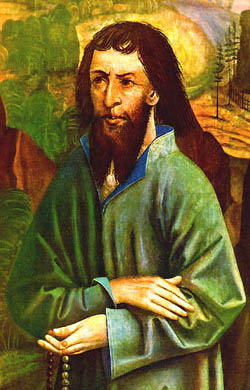
Picture of St. Nicholas of Flue from the parish church in Sachseln
|
At age 23 he was called to take arms in a campaign against the canton of Zurich, which rebelled against the Swiss Confederation. Fourteen years later he was still engaged in military service and had achieved the post of captain, having 100 men under his command. In battles Nicolas always fought with the sword in one hand and the rosary in the other. His courage earned him the highest military decorations.
Returning home, he was asked to be mayor of his city, but declined the honor, alleging his humble origin made him unsuitable for that post. However, he accepted the position of judge in the local court, a position that he carried out with rare ability for nine years. Then he retired from this position to his farm to have more time to dedicate himself to matters of the soul.
He had received symbolic visions since childhood. After his retirement, he was watching his flock when he mystically saw a marvelous lily growing from his mouth and rising up to the clouds; suddenly it fell to the ground and was eaten by a horse. He understood that his contemplation of heavenly things was often disturbed and consumed by earthly concerns. He realized he should abandon the world and devote himself exclusively to matters of soul as a hermit.
Although she had just borne his tenth child, his wife heroically consented. He settled at Ranft, a few miles from his home. From the outset of his life as a hermit, he was miraculously nourished only by the Holy Eucharist, which he received once a month.
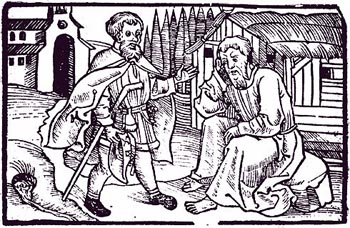
Many pilgrims came to consult St. Nicholas, known as Brother Klaus - Chronicle of Johann Stumpff, Zurich, 1548
|
He was loved and venerated by the people, and pilgrims came from distant parts to consult him. He was often called on by dignitaries to make peace between the cantons in their continuous disputes. He always achieved success in those missions.
Shortly before his death he was assailed by strong pains. “O, how terrible is death!” he used to say. But he delivered his last breath in peace. His body was preserved in the Church of Sachseln, a village close to his birthplace.
Even today the visitor can venerate there the bones of Brother Klaus (Nicholas in German), his mortal remains richly ornamented with gold and precious stones, and around his neck countless military decorations of honor.
Note: After Vatican II, the richly adorned reliquary, which also served as an altarplace, was replaced with a table and simple modern contemporary tomb without the jewels or military decorations.
Comments of Prof. Plinio:
To better admire the life of St. Nicholas of Flue, let me propose several presuppositions and make some observations.
First, at that time, like today, Switzerland was divided into cantons, which are small provinces. Each canton had an almost complete independence, subordinate only to a Swiss Confederation that exerted a vague authority over them all. They frequently were engaged in disputes and fights, because the neighboring countries exerted different influences over the various cantons. For example, in one canton, they spoke French, in another, German; in another, Italian, etc., and each canton was normally influenced by the neighboring country to which it had culturally closer ties. This generated intense political disputes often followed by military engagements.

15th-century Switzerland produced many special military units like the Swiss Guards
|
You should consider also that the 15th century in Switzerland was a military epoch. It was in that period that the Swiss people revealed themselves to be great warriors, providing troops and special guard units for all of Europe. In particular the Swiss Guard, which still serves the Popes today, is a remnant of that tradition. In such a scenario St. Nicolas of Flue was called to take up arms against the canton of Zurich.
Second, you can imagine this valorous man in the battlefield, carrying his sword in one hand, and his shield and rosary in the other. It is a beautiful battle scene! Today you can see how the connotations that surround objects of piety have changed because of sentimentalism. Today, who would say that a rosary reminds one of a warrior? On the contrary, more often it calls to mind a man incapable of fighting. This religious sentimentalism worked an almost complete change. This is a grave injustice to the rosary.
Third, it is interesting to see how St. Nicholas showed a profound spirit of hierarchy when he declined an important public post that was offered to him. He said, “No, I am from a humble condition, and I don’t want to exert authority over persons who are higher than me by birth.” Such a thing no longer exists in our century. Today egalitarianism has invaded everything, and we have the opposite: the rejection of someone because he has a higher condition and the preference for the lower. That is, the scale of values has been completely inverted.
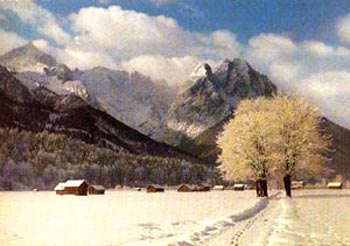
Above, a scene from the Swiss Alps, where St. Nicholasherded his cattle.
Below, the Parish Church of Sachseln where his relics are preserved
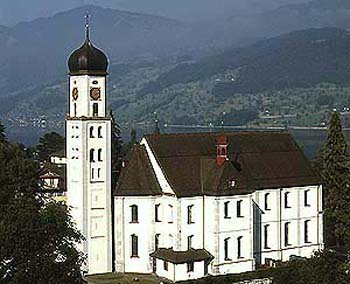
|
Fourth, he had visions throughout his life, which was a fairly common life. So you should consider Nicholas of Flue the warrior, the judge and the shepherd having visions as he carried out these different occupations.
You can imagine the scene of the judge Nicholas of Flue seated in the small tribunal of his canton and listening to the different sides of a suit. As the persons are presenting the case, suddenly someone notices that the judge has a distant gaze that reveals he is in ecstasy. He becomes illuminated, seeing a heavenly scene. The talking ceases in the tribunal; the hatred and differences dissolve; when the vision ends the opposed parties are reconciled; the case is resolved. Do you know some judge like this? How everything has changed in our days!
You can also imagine the shepherd in the poetic Swiss landscape. In the background are the Alps covered with snow, which at sunset take on pink or light blue hues. St. Nicholas of Flue is there blowing a horn to assemble his dispersed cattle. He stops and prays the Angelus by himself, and then heads toward the stables with the cattle. At this moment he receives the visit of an Angel who shows him Heaven and reveals this or that marvel to him. When he returns, the cattle are all in the stable, quiet and bedded down for the night, led there by another Angel who took care of them. The Angels, the innocence of the Swiss landscape and the soul of St. Nicholas of Flue fit together perfectly. It is something truly superior!
Fifth, the vision of the lily that fell and was eaten by an animal showed him that his high contemplation was often destroyed by earthly concerns. If some of us have an analogous problem – and I think that many of us do – we should take St. Nicholas of Flue as our patron saint. We should ask him for the grace to not demean the graces we receive and to sustain our good thoughts. It is encouraging for us to see that saints have the same problem we have.
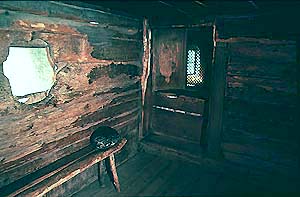
The cell from the hermitage of St. Nicholas in Ranft
|
Sixth, the last thing you can consider is how richly the faithful decorated his remains. It reveals their veneration for sanctity. It is curious also to see the many military decorations around his neck. These were not just the ones he earned during his lifetime. The descendents of St. Nicholas of Flue began to place the military decorations they received there also. With this excellent tradition, they show that it is more honorable for them to be descendents of the saint than to wear the decorations they receive. It is an action full of meaning.
These are the points I offer for your meditation in admiration of St. Nicolas of Flue, asking him to give us the courage to always have the sword in one hand and the rosary in the other in the difficult fight we are engaged in today.


  | | Prof. Plinio Corrêa de Oliveira | |
The Saint of the Day features highlights from the lives of saints based on comments made by the late Prof. Plinio Corrêa de Oliveira. Following the example of St. John Bosco who used to make similar talks for the boys of his College, each evening it was Prof. Plinio’s custom to make a short commentary on the lives of the next day’s saint in a meeting for youth in order to encourage them in the practice of virtue and love for the Catholic Church. TIA thought that its readers could profit from these valuable commentaries.
The texts of both the biographical data and the comments come from personal notes taken by Atila S. Guimarães from 1964 to 1995. Given the fact that the source is a personal notebook, it is possible that at times the biographic notes transcribed here will not rigorously follow the original text read by Prof. Plinio. The commentaries have also been adapted and translated for TIA’s site.
|
Saint of the Day | Home | Books | CDs | Search | Contact Us | Donate

© 2002- Tradition in Action, Inc. All Rights Reserved
|
 |

|